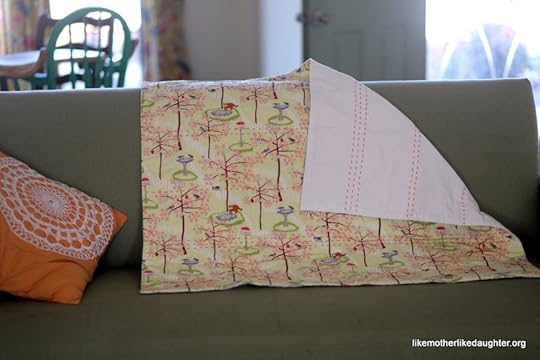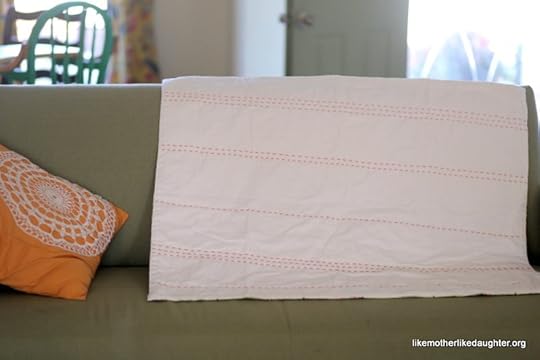Leila Marie Lawler's Blog, page 49
June 24, 2016
The chapter they all “jumped on”: Orientation ~ The Spirit of the Liturgy, A Book Club
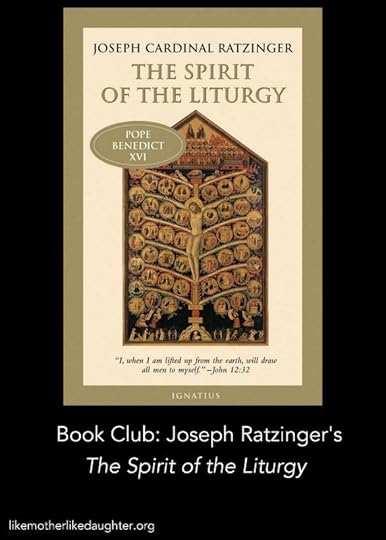
{Book Club: The Spirit of the Liturgy}
I hope you will read along in this book club (or just read my posts, that’s okay): Joseph Ratzinger’s The Spirit of the Liturgy.
(When you buy something via our Amazon affiliate link, a little cash rolls our way… just a little. Thanks!)
I’ll post on Fridays, although for this longer book, perhaps not every Friday. I’ll give you your homework, I’ll talk about what we read, we’ll discuss in the comments. Even if you read later, the comments will still be open.
Previously:
Introduction to the reading: Joseph Ratzinger’s The Spirit of the Liturgy: A Book Club for Easter and Beyond
Nature or history in worship? Or both?
The Relationship of the Liturgy to Time and Space: preliminary questions
Homework: Read Chapter Four of Part II.
Chapter Three, Part II: The Altar and Direction of Liturgical Prayer
In his “On the Inaugural Volume of My Collected Works”, Pope Benedict XVI says about The Spirit of the Liturgy,
Unfortunately almost all the reviews jumped on a single chapter: “The Altar and the Direction of Liturgical Prayer”. Readers of these reviews must have concluded that the whole work dealt only with the direction in which Mass is celebrated; that it was all about trying to reintroduce Mass celebrated by the priest “with his back to the people”. Given this distortion, I thought for a while about omitting this chapter [for this present volume, in which The Spirit of the Liturgy forms the main text] — nine pages out of a total of two hundred — so that finally a discussion could begin about the essential things in the book about which I had been and am concerned.
He here mentions “two excellent studies” in which “this question” is treated with a clear result: “The notion that priest and people should look at each other while praying appeared only in the modern era and was completely foreign to ancient Christendom.”
Benedict continues to downplay this issue: “But with that I may once again have said too much on this point… [which is] actually only a detail… ”
Yet he finishes the introduction with a thought that belies his apparent trivialization of the question of orientation. He says, in The Spirit of the Liturgy: “I tried to present… three concentric circles… [1] the intrinsic inter-relationship of the Old and New Testament… [2] the relationship to the religions of the world… and finally, [3] the cosmic character of the liturgy, which represents more than the coming together of a more or less large circle of people: the liturgy is celebrated in the expanse of the cosmos, encompassing creation and history at the same time.”
To me, when I consider that he did not leave out “nine short pages” in this, his legacy, but actually returns to them in this preface, I must conclude that he is trying to disarm our resistance by seeming to make light of something that actually can’t be dismissed — the way a parent seems to push away a plate of food being disdained by a malnourished but stubborn child. He winds up his introduction:
This was what the orientation of prayer meant: that the Redeemer to whom we pray is also the Creator and, thus, that the liturgy also always contains a love for creation and the responsibility for it. I would be happy [if this book] could help others see the greater perspectives of our liturgy and put petty quarrels about external forms in their proper place.
The chapter we are reading here, this very troublesome chapter, attempts to open our eyes to these “greater perspectives.”
***
We hear a lot in our society about “listening,” about “hearing the other side,” about how “understanding leads to acceptance,” — yet with this controversy, it seems that people refuse to delve into the question beyond their own preference.
Ironically, it’s the anti-traditionalists who seem to be most attached to their “tradition”: “It’s always been done this way!” they cry.
But that is not true.
In this chapter, Ratzinger leads us step by step to understanding why history and logical conclusion (from the argument of what the essence of worship is) affirm the orientation of the priest and the people to the East.
He shows that Christian worship cannot be only representational sacrifice or abstract detachment from time and place. It must be both and more.
A physical orientation retains the incarnational character of Christian worship. “The cosmic symbol of the rising sun expresses the universality of God above all particular places and yet maintains the concreteness of divine revelation.”
You might say that it lifts our mind out of itself and even out of the narrowness of this world. It expands the horizon of sanctification above the earth, raising our eyes from an earthly city (for instance, Jerusalem, or possibly Mecca — or even Rome!) higher, to include the cosmos itself; and in so doing, we reclaim our original directive from God at the Creation: to sanctify the created world.
Ratzinger addresses all the objections, most of all the one which posits that “versus populum” (priest and people facing each other) most replicates the idea of meal and represents the Last Supper. The celebratory meal in antiquity, however, did not feature the host facing the people; rather, there would have been a horseshoe-like configuration, leaving a side open for service. In other words, host and people would have faced the same direction, more or less.
But even more,
The Eucharist that Christians celebrate really cannot adequately be described by the term “meal”. True, the Lord established the new reality of Christian worship within the framework of a Jewish (Passover) meal, but it was precisely this new reality, not the meal as such, that he commanded us to repeat… the Eucharist refers back to the Cross and thus to the transformation of Temple sacrifice into worship of God that is in harmony with logos. (P. 78)
If we are talking about the Church before the 16th century, “the only thing ever insisted upon, or even mentioned, was that [the priest] should say the eucharistic prayer… facing East… Even when the orientation of the church enabled the celebrant to pray turned toward the people [i.e. the building faced west]… it was not the priest alone who, then, turned East: it was the whole congregation.” (P. 79)
(You can visit the Church of San Clemente in Rome, near the Coliseum, to verify this. It’s a beautiful fourth century church, well worth a stop. Essentially, the Mass was celebrated with the priest behind the people, so important was orientation to worship.)
Interestingly, the former arrangement (of the priest and people facing East together during the Eucharistic prayers) downplayed the importance of the priest; today’s arrangement makes him the focal point — “an unprecedented clericalization came on the scene.” (P. 79-80)
Even where some recovery of reverence has made the priest more conscious of directing his attention to the altar, the people — who cannot see what is on it very clearly — are naturally drawn to focusing on his face and his gestures. Where the rubrics require him to lift his eyes, we can’t be surprised that he looks at what he sees — the people! Most of the time, the priest speaks prayers meant for God while making eye contact with parishioners. (I haven’t done a scientific study, but I have been in many, many parishes all over the country and also in Europe, and I find this to be so universal as to give me a jolt when it doesn’t occur.)
Ratzinger’s worry is that the experience most likely to be found in today’s parish in the West is one driven by entertainment value. The priest’s “creativity sustains the whole thing.” And that disastrous development brings in its wake a whole host of other problems with those in the congregation vying to contribute their creative contributions as well. Pretty soon, every part of the Mass is up for grabs, ready to be exploited by whatever interest group clamors for it or seems to need affirmation. (P. 80)
It’s no use bringing up your own parish or wonderful priest as a counter-example, for the huge and burgeoning “liturgical resource” industry backs up my claim.
The turning of the priest toward the people has turned the community into a self-enclosed circle. In its outward form, it no longer opens out on what lies ahead and above, but is closed in on itself. The common turning toward the east was not a “celebration toward the wall”; it did not mean that the priest “had his back to the people”: the priest himself was not regarded as so important… As one of the fathers of Vatican II’s Constitution on the Liturgy, J. A. Jungmann, put it, it was much more a question of priest and people facing in the same direction, knowing that together they were in a procession toward the Lord. They did not close themselves into a circle; they did not gaze at one another; but as the pilgrim People of God they set off for the Oriens, for the Christ who comes to meet us. (P. 80)
I remember a pastor we had long ago explaining why he was removing the altar rail, where parishioners could receive Holy Communion kneeling, in favor of a line for receiving while standing. He said we are all pilgrims on the way to meet the Lord, at Mass and at the Second Coming. But this rang false, because it was an explanation drummed up to justify an innovation — one that came in the wake of that other innovation, the versus populum, which itself removed the actual symbolic value of what he was trying to impose on this one.
It was an effort (he was basically a good man, don’t get me wrong — he had to do what the bishop directed), but one without real roots in the ancient practice of the Church, sustained for centuries. And one which would have been completely unnecessary, had things been left as they were.
Ratzinger completely agrees that the liturgy needed some attention and reformation.
When the altar was very remote from the faithful, it was right to move it back to the people… It was also important clearly to distinguish the place of the Liturgy of the Word from the place for the properly Eucharistic liturgy [and this theology of the two places he explicated in the previous chapter on the church building]. For the Liturgy of the Word is about speaking and responding, and so a face-to-face exchange between proclaimer and hearer does make sense. .. On the other hand, a common turning to the east during the Eucharistic Prayer… is not a case of something accidental, but of what is essential. Looking at the priest has no importance. (P. 81)
But, the cry goes up, this is nostalgia!
To which he replies, “Are we not interested in the cosmos anymore? Are we today really hopelessly huddled in our own little circle? Is it not important, precisely today, to pray with the whole of creation?… to find room for the dimension of the future…?”
And in one of his rare fits of temper, he takes on the objection that in facing each other, we see God’s image in man.
I find it hard to believe that the famous critic [Häussling] thought this was a serious argument. For we do not see the image of God in man in such a simplistic way… but only with the new seeing of faith… But if we are to do this, we must learn a new kind of seeing, and that is what the Eucharist is for. (P. 83)
Then, in that charmingly gentle, practical way of his, Ratzinger takes on the issue of how this turning to the East is to be accomplished, given that many churches are not oriented this way. For Americans, especially those of us living in older, built up, and decidedly Protestant-influenced areas of the country, this is a problem. In New England, very often the Catholic Church can be found somewhat shoe-horned into its spot. We can only dream of a piazza opening its welcoming arms to passers-by, and the site had to dictate the placement of the edifice.
Remember in the last chapter when I mentioned that his comment about how, in the early Church, the crucifix became associated with the East would come up? Here he suggests that we make the most of this deep association and place the crucifix on the altar (in addition to the one behind it or above it, already required by the rubrics). Thus, priest and people can “orient” themselves to this symbolic “east” which is Christ.
The only possible objection to this easily accomplished reform would be that a crucifix interposes an object between the priest and the people. Only if the Mass is expected to entertain does this present a problem! No, the objection reveals a misunderstanding of what the Mass is, in its essence. If Guardini and Ratzinger can’t bring about understanding, then we are truly in a difficult place.
However, in the introduction I quoted from at the beginning of this post, taken from the Ignatius Press volume of his collected works, Benedict continues: “Meanwhile, the recommendation that I made at the end of the pertinent chapter [this one] in my book has fortunately been adopted more and more widely: not to make structural alterations, but simply to put a cross in the middle of the altar for the priest and the faithful to look at together, so as to allow themselves in this way to be led to the Lord to whom we all pray together.”
So that’s hopeful! A simple but effective reform towards reclaiming the meaning of the liturgy. Why, it could be implemented in your parish very soon, could it not?
Were there any other passages you’d like to talk about?
Questions? Comments? I’d love to hear from you!
(Emphases added in quotes are mine.)
Click here to see our previous discussion of Romano Guardini’s The Spirit of the Liturgy, which you can read free, online. You can also purchase it here, although be warned, this edition does not have the footnotes, which stinks .
.
The post The chapter they all “jumped on”: Orientation ~ The Spirit of the Liturgy, A Book Club appeared first on Like Mother Like Daughter.
June 23, 2016
{pretty, happy, funny, real}
What is this {pretty, happy, funny, real} you speak of?
~ {pretty, happy, funny, real} ~
Capturing the context of contentment in everyday life ~
Every Thursday, here at Like Mother, Like Daughter!
Well, it’s my turn for {phfr}, but it appears I didn’t really take any photos of what’s been going on in the last week or so. But if this one of Nora proudly proving that she can in fact reach any horizontal surface in the house seems to project a certain amount of chaos, well…
[image error] Loading InLinkz ...
The post {pretty, happy, funny, real} appeared first on Like Mother Like Daughter.
June 22, 2016
Three martyrs for marriage.

{Last year I had a post about the upcoming feast of the Nativity of St. John the Baptist. As today is the feast of Saints Thomas More and John Fisher, martyrs, I thought I would put the thoughts I had there back up, with a few little changes to suit the timing, for your consideration.}
Say, it’s better to light a candle — or light a bonfire! — than curse the darkness. By all means, celebrate today. And then…
Friday, June 24, is a high holy day (a solemnity): the Feast of the Nativity of St. John the Baptist. But it’s a day that has slipped out of memory, and I’d like to propose to you that we all do something to rescue it — for the sake of this world of ours, and to give glory to God in his amazingly detailed plan of salvation.
How about having a bonfire, as those of old did? Or something as close to one as you can manage, if it’s cold, or too drought-ridden, or what have you, where you are?
Last year at this time, the Supreme Court was preparing to hand down a decision on the fate of marriage in this country. This was a cause for real prayer, fasting, and repentance. And it still is.
Yes, repentance — because the poor souls who want to undermine the proper arrangement of things are merely taking to the logical conclusion attitudes, actions, and laws that supposedly moral people have lived with for a long time. Attitudes like approving of cohabitation and blinking at pornography; actions like separating the marital act from its haven, the marriage bond; laws allowing killing the child in the womb and accepting that a marriage can be broken without recourse — in short, doing away with all those walls that seemed so confining but really, kept the people together and protected the weak.
What did we think was going to happen?
We need to ask forgiveness. We need to help our leaders in the Church see that it’s their duty to be sorrowful for bringing all this about, or at least cooperating out of a false sense of charity.
A reader had pointed out that these two feasts, today’s and the 24th’s, are quite significant and germane to this very issue.
So, so true.
We need to rise to the occasion.
Read this marvelous essay by Fr. James Schall on “A small Point of Doctrine.” In it he explains that yes, More (and Fisher) resisted to the death for something that hardly seems worth it, it’s so small a point — but it is worth it.
“We sometimes think that it might be nobler to die upholding the truth of the Incarnation than in upholding, say, chastity, as Maria Goretti did. But the truth is that Catholic teaching is a whole; the denial of any one of its teachings, when logically stretched out, undermines the whole order. And someone will always be found to stretch it out. Not only is this teaching of the coherence of the whole true on the revelational side of Catholicism’s content, it is also an integral whole on its philosophical side. Both reason and revelation belong together in one coherent whole. Indeed, we can say that if even one central doctrine, taught or understood as infallible, is, in fact, clearly untrue, the whole edifice falls. Belief would be no longer feasible.”
“More was a scholar who saw the intimate connection between mind and reality. He saw that the function of the Successor to Peter is to uphold clearly, wisely, and compassionately, the truths handed down to be explained and affirmed in every age. He saw that he must “witness” to this “abstract truth,” even if he must stand alone, and lonely, in an obscure cell to do so. Had his “witness” not been so firm, Henry might well have laid claim to rule, not only the city, but the mind.”
John the Baptist is a most opportune saint to remind us of the beauty of the intimate sisterhood of women (the meeting of Mary and Elizabeth) and the sacredness of the child in the womb (“For behold, when the voice of thy salutation came into mine ears, the babe leaped in my womb for joy”).
It helps us ponder the Incarnation and indeed the nuptial meaning of the human body.
His birth is celebrated at a time that has been called “Summer Christmas” — for June 24th is six months before December 24th (remembering that Jesus was born at the deepest night), and just after the summer solstice, as Christmas is just after the winter one.
You see how God shows us, in His cosmos, the meaning of “I must decrease, He must increase.” In this way, Christianity rightly claims the workings of the whole universe for her own, rescuing them from the grip of the pagans, who have a limited understanding of nature and can’t help perverting it.
Traditionally, Catholics have a bonfire on the vigil of this feast, the night of the 23rd. There are many lovely customs associated with the celebration. One is to throw any palms leftover from Holy Week right in the fire.
You can read about this feast on Catholic Culture: their bonfire post is taken from this very book by Mary Reed Newland, the writer who most impressed upon me as a young mother the need to stay close to the liturgical year of the Church. I know you will love her!
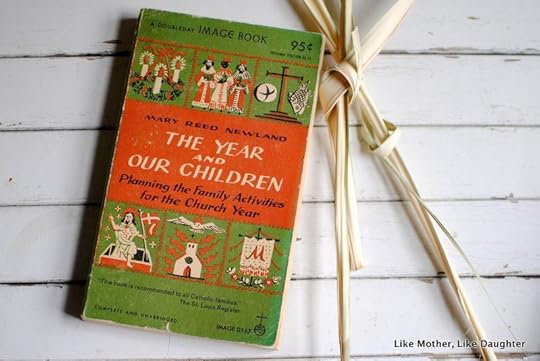
(Sophia Press has re-issued her book (last year I had a giveaway and that’s when I originally wrote this post) — it makes a great companion to our book, The Little Oratory.)

In fact, in our book we didn’t go to great lengths to include every liturgical celebration in detail, simply because we knew there is Newland’s book for you to consult (as well as the excellent Catholic Culture posts, curated by Jennifer Gregory Miller).
Learn about Thomas More: Read Thomas More: A Portrait in Courage , an inspiring biography that can be shared with the family, and watch the great movie A Man for All Seasons (quotable and definitely the Chief’s favorite movie ever!). Consult Catholic Culture for some ideas for your celebration. (The image of St. Thomas More on my kitchen corner cupboard is painted by David Clayton. Contact him at his site to find out how to get one.)
, an inspiring biography that can be shared with the family, and watch the great movie A Man for All Seasons (quotable and definitely the Chief’s favorite movie ever!). Consult Catholic Culture for some ideas for your celebration. (The image of St. Thomas More on my kitchen corner cupboard is painted by David Clayton. Contact him at his site to find out how to get one.)
Maybe make tomorrow, the 23rd, a day of penance and prayer. Really pray for our lawmakers, judges, and executives. Pray for our bishops and the Holy Father. Let’s decide to give up something for the sake of our country and our freedom, and for the courage of our leaders in faith.
Then, either tomorrow evening, the vigil, or Friday evening, have a great bonfire! Invite your friends and neighbors! Let the penance cease! Let’s ask John the Baptist to show us the way to living in love and justice.
This — prayer, fasting, repentance, celebration — is how we transform the world.
The post Three martyrs for marriage. appeared first on Like Mother Like Daughter.
June 21, 2016
A simple baby quilt or two.
One of the best parts about having a blog (even when you yourself are something of a delinquent blogger) is that every so often, you will be trying to remember how you solved some problem in the past, and you can ASK the INTERNET what you did, and the internet will KNOW, because you TOLD it. This is what happened to me recently while finishing up a quilt, and I was led down a rabbit hole reading about my own past crafting projects. I was reminded of how many of you lovely ladies encouraged me to persevere and/or give up on this truly desperately ridiculous quilt, and I so appreciated the encouragement in both directions that I feel compelled to update you with the results.
After cutting my project up into little bits and sewing it back together again a few times, I ended up with a quilt top that was actually sort of not too terribly un-cute. By that point I was so dreadfully tired of thinking about it that I folded it up, shoved it onto my works-in-progress shelf, and ignored it for six months or so. Then, last fall, when I was in the midst of some life-changingly magical tidying, off to the thrift store it went, in hopes that it sparked joy in some other poor crafting fool. I have no regrets on this point whatsoever.
These are different quilts. Joy-sparking quilts. Sweet little baby quilts for darling little babies.
This first one was for our godson Freddie, though of course since I’m a delinquent, he didn’t get his baby quilt until several months after his little brother was born. Luckily he’s still too young to notice.
I did buy the fabric while I was still under my self-imposed fabric-buying ban, but who could resist those FOXES? I had to do it. With a simple little bow tie block on the front, it made for a happy little quilt for a happy little guy.
I quilted with my now go-to of pearl cotton thread outlining the blocks and the bow ties. (Are they still bow ties in this simplified version? I’m not quite sure that they qualify, but that’s what I’ve been calling them.)
This one was my dear friend’s baby girl, and apparently it takes five babies for Auntie Rosie to get her act together enough to send a quilt, because I don’t think I ever manged to do it for Ciara’s four older brothers and sisters, whom I also love. But clever Ciara happened to be born when I was in the midst of a crafting spree, and she happened to be a girl, which coordinated nicely with my stash.
I had the darling fabric already — my mother had given it to me, actually, and I pulled it out several times for various projects, but never could bring myself to cut it up. I finally realized that I needed to make it into a little wholecloth quilt.
Instead of using bias binding on this one, I just sandwiched it, turned it inside out, and topstitched. The quilting is very simple, as you can see, and a little random, but it just seemed like it suited.
Now that I’ve had a few babies myself, I realize that I end up with lots of photos of them lying on their blankets. When they’re little and immobile, I spread it out and plop them down for tummy time or hanging out (or, what we refer to as “hypnotizing the baby,” aka, lying them down under a ceiling fan). Then, since I suddenly am not holding the baby anymore, I grab a camera and start taking photos. For this reason, I do try to make sure I have a lot of white on at least one side of my quilts, the idea being that it helps reflect lots of light for optimal cuteness capturing.
At this point, I wish I had some optimally cute photos of the quilts in action! Alas.
The post A simple baby quilt or two. appeared first on Like Mother Like Daughter.
June 20, 2016
Read this, not that ~ books for your voracious reader!
Do you know this “eat this, not that” series of books? The idea is to help you make good choices in food and drink to avoid hidden calories that will tank your health. Well, Rosie had the thought that we could do something similar with books for the Library Project*.

I am concerned when I see reading lists out there for children, that a lot of them have books from a 20-year time period — that is to say, from now. And they are about “now” — about kids “like you” — only, how does that work? Could it sometimes work that a child reading these stories acts more like the child in the stories… who are supposed to be just like him? Maybe that’s not such a good thing. Modeling behavior that reflects your own behavior will tend to spiral downwards, behavior-wise. We don’t want that.
And then, not only do we want our children to read good books, we want them to know how to find good books on their own.
Call it a “lost tool of learning” — the skill of being able to find things to read on one’s own.
Truly, this was one purpose of the public library: to allow the reader to follow his nose. Sadly, unless your library is old and too poor to have purged its stacks, you probably can’t trust it enough to let your child loose in it.
(Teaching children to be active about finding what they are interested in is another reason I highly recommend the Bobbs-Merrill readers, old as they are. Many of the selections have, in the “assignment” section, suggestions for looking things up in the library. You will find that they are so helpful for getting your child to learn to look things up in the library and go on a hunt of his own.)
And that is why I do recommend having more books, actual, physical books, in your home than you are necessarily reading at the moment, even if it goes against your minimalist tendencies, and even if you do have good reading on the Kindle. It has to do with exposure, and a sort of externalizing of the list — putting it out there where it can be seen, handled, explored, and even abandoned for the moment.
The other day I got down a couple of boxes I had stowed in the attic. And so I came across these books again:

They are called Best in Children’s Books, published by Doubleday. They are out of print, but you can get them for pretty cheap ($5 or so including shipping). You can probably find them at book sales. You could get them one by one and it would be like having a hard-cover literary magazine for your children, delivered! You can find a whole list of them, in order, here.

Each book has a fantastic assortment of poetry, tales, history, and geography. The illustrations are charming. There’s something for each age level, which I endorse, because not only does it challenge the slower/younger reader to do more, but it allows the faster/older reader to linger on material that might still offer something for his development. And then, there’s always the possibility that your older child will read something to the younger ones!
If your child finds a story he likes, why, you can help him find more of the same author.
I also want to be sure to mention some other authors for your older, more voracious readers, both boys and girls, although perhaps the boys will enjoy the first ones more:
C. S. Forester, the Horatio Hornblower series. High adventure featuring a boy who has to work with his unhardened youth and essential sensitivity to survive in a man’s world. The TV shows were very good as well, but of course, read the books first.
Alexandre Dumas, The Three Musketeers and its sequels. Robert Louis Stevenson loved this book, and why not? Adventure, romance, friendship, swashbuckling swordplay! The only thing to prevent a young person from adoring this book is the first page. Just tell him to keep at it.
Baroness Orczy, The Scarlet Pimpernel. A romantic and adventurous tale of hidden identity set during the French Revolution.
Also by Alexandre Dumas, The Count of Monte Cristo. Nothing, nothing can compare with the beginning of this book, with its tale of unjust imprisonment and impossible escape. Even though the second part of the book doesn’t quite live up to the first, it’s a story well worth reading. Kind of the ultimate beach book, going on and on…
Don’t get abridgments, by the way. The whole point is to keep them reading!
*What is the Like Mother, Like Daughter Library Project?
The post Read this, not that ~ books for your voracious reader! appeared first on Like Mother Like Daughter.
June 18, 2016
{bits & pieces} and an Infinifeed Nursing Scarf review and giveaway!
The weekly “little of this, little of that” feature here at Like Mother, Like Daughter!
Care to see my new infinity scarf? It’s more than meets the eye.
(NB: Anyone want to come be my fashion photographer next time I do this? 100 attempts later…)
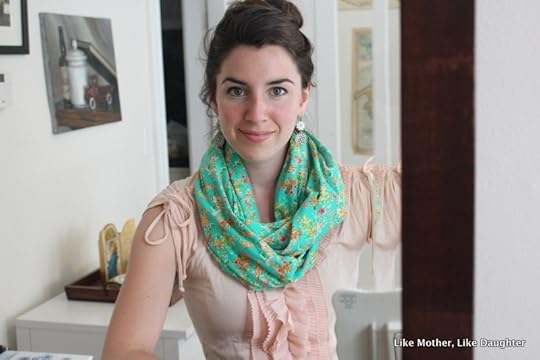
It’s cleverly designed to transform for heavy-duty nursing coverage.
You know that we’re fans of using scarves to do a quick, make-shift cover up when you want a pull-down option (rather than pulling up your shirt from the waist). And here at LMLD we’re not of the opinion that you must have a cover, because we basically think that nursing is just normal and should fit into your routine casually and seamlessly. No need to make a fuss over it.
But there are those times when you maybe do need to cover up. And if you have a baby like my spirited one-year-old, it can be hard to keep the affair under wraps with just a normal neck scarf or a Bebe au Lait-type-deal.
For such times, Letty (a fellow CUA alumna of mine) came up with a cover that really does keep things under wraps, and which also sits comfortably around the neck as a scarf! It can also double as a carseat cover if you’re so inclined.

Here’s what I found with my Infinifeed (which, for full disclosure, Letty provided for me at no charge [and even let me pick out a brand new fabric, as she was updating her inventory – lucky me!] in exchange for this review).

Bottom line: It is the one option that I have that really does keep me covered when I want to nurse while wearing a front-opening top. My Peabodee pulls those things aside like it’s his job to cause me to blush. But when this thing goes on, he settles down knowing that it’s not going anywhere. And I can relax a little knowing that I’m going to accidentally flash someone any second.
It is a beautiful fabric that I genuinely like to put on as a scarf – it often will take my outfit up a notch!
I do find that it’s a bit chunkier than I would normally want a scarf to be.
There’s a “right side” and a “wrong side,” so it takes some careful arranging to put it on as a scarf without the “wrong side” showing. Switching it over from scarf to nursing cover also takes a few beats: if you want to have it on in the technically correct position, you have to take it off and find the snap to make the proper closure and get it over your head and adjusted around your shoulders. It’s a little bit of work if you have a baby fussing for milk immediately.
The weight of the one that I have is heavy enough that I won’t plan to use it in the heat of summer. It would definitely create a sweaty tent effect.
I should say, though, that Letty explained to me that the printed ones are cotton, whereas the plain colored ones are modal, a fabric which is stretchier and softer. Not only do the modal ones drape a bit lighter (expect less of the chunkiness I described), but they are also the same on both sides, so they’d be easier to wear – no concerns about the “wrong side” showing. Buuut the cotton ones are sturdier and will hold up to normal washing better, whereas the modal is a bit more delicate.

I’ll also mention her headbands since she tossed one in on the deal for me:
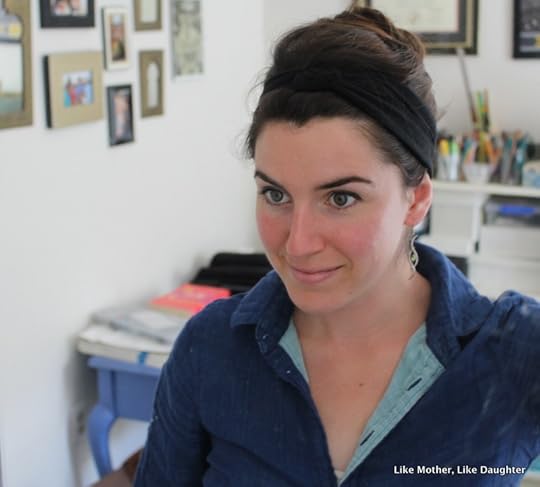
If you’re like me, you have what I call “baby fuzz” bordering your hairline at around 7 months post-partum, and “baby bangs” by 12 months. A cute headband can be an appealing solution when you want your hair back.
But if you are further like me, your head has become ridiculously sensitive since having babies, and all conceivable options for hairbands become torturous after an hour! I have to say that this headband truly is soft, and the clever design adapts firmly to any head. I suggest a spritz of hairspray along the inside of the band to keep it from slipping back if you have straight/fine/slick hair.
Letty has a very sweet and distinctively Christian business model going on. I received her scarf promptly, in pleasing packaging, and noted from her website that she gives a tithe of all her Pebblehut earnings to help women in crisis pregnancies. She has a lovely little growing family of her own to look after. So if you are interested in one of her nursing scarves, ponchos, headbands, or baby swaddle sets, etc., you can feel good about supporting this small business! I’m sure that she’d be happy to answer questions in the comments, as well.
With all that said — the giveaway:
One lucky winner receive a free Infinifeed nursing scarf from Letty, and she’ll even let you pick out which one!
All LMLD readers will receive free shipping on orders over $30 until the end of July when you use promotional code “likemother” at checkout.
Enter below to win! (We’re giving our Rafflecopter-loving readers a turn!)
Click here to enter!
~~~~~~~~~~~~~~~~~~~~~~
On to this week’s links!
I can’t help but shake my head at the widespread confusion following the recent Stanford scandal. The truth that major sources don’t want to point out is that college-aged girls are suffering terrible treatment in general — that, in fact, most people in our country are suffering, in varying degrees, the effects of the sexual revolution. Check out the Ruth Institute and see if your story can maybe be part of a project that aims to build up the culture by first acknowledging where we have suffered.
Some things you just can’t make up: 6 Catholic Headlines that Weren’t Eye of the Tiber.
We love seeing how things are made.
Have you been noticing the word “hate” misapplied, recently? Terrorism is not hate.
A beautiful reflection on the the shooting at Pulse: “No, homosexuality can never be normalized, nor Christianity stripped of its strangeness. Real solidarity of the religious and the gay will emerge not between the well-scrubbed and presentable gays and the supposedly religious who are just liberals in clerical drag, but between the promiscuous and disreputable gays and the religious nuts who scandalously “stand on the word.”
Laundry on the line and the body, and the soul (a poem Bridget shared with Mom recently): Richard Wilbur, Love Calls Us to the Things of This World
In the liturgical year:
Today we honor Saints Marcus and Marcillianus, twin brother saints!
From the archives:
Dinner when things quiet down: Roots and Wings (I’m just including this one because it which also has good links within it!)
That time you realize you are living the dream…
~We’d like to be clear that, when we direct you to a site via one of our links, we’re not necessarily endorsing the whole site, but rather just referring you to the individual post in question (unless we state otherwise).~
Follow us on Twitter.
Like us on Facebook.
Auntie Leila’s Pinterest.
Rosie’s Pinterest.
Sukie’s Pinterest.
Deirdre’s Pinterest.
Habou’s Pinterest.
Bridget’s Pinterest.
Habou’s Blog: Corner Art Studio.
Auntie Leila’s Ravelry.
Auntie Leila’s Instagram.
Rosie’s Instagram.
Sukie’s Instagram.
Bridget’s Instagram.
Save
Save
Save
Save
Save
Save
Save
Save
Save
The post {bits & pieces} and an Infinifeed Nursing Scarf review and giveaway! appeared first on Like Mother Like Daughter.
June 17, 2016
The Church Building ~ The Spirit of the Liturgy, A Book Club

{Book Club: The Spirit of the Liturgy}
I hope you will read along in this book club (or just read my posts, that’s okay): Joseph Ratzinger’s The Spirit of the Liturgy.
(When you buy something via our Amazon affiliate link, a little cash rolls our way… just a little. Thanks!)
I’ll post on Fridays, although for this longer book, perhaps not every Friday. I’ll give you your homework, I’ll talk about what we read, we’ll discuss in the comments. Even if you read later, the comments will still be open.
Previously:
Introduction to the reading: Joseph Ratzinger’s The Spirit of the Liturgy: A Book Club for Easter and Beyond
Nature or history in worship? Or both?
The Relationship of the Liturgy to Time and Space: preliminary questions
Homework: Read Chapter Three of Part II.
Chapter Two, Part II: Sacred Places — The Significance of the Church Building
This chapter is pretty straightforward, although I suppose that there are those people from hippie days who see no reason for buildings, but insist that it’s more authentic to worship in the great outdoors. I would like to have time to bring up the subject of whether, as originally intended by the Creator, the outdoors itself (the entire Cosmos, that is) was meant to be a Temple, and that these free spirits are misguided when they suppose that they are rejecting the notion of any sort of structure when they choose to commune with the Great One without the “necessity” of walls.
Such an inquiry is not within my competence, however, as I am not a Hebrew scholar or a theologian, so we will go with the assertion at the start of the chapter to the effect that everyone agrees that the Christian community needs a place to meet.
{By the way, if we were discussing this out on the deck, I would have to exclaim a bit about how this is the sort of discussion I love — seemingly obvious or even mundane, but getting, finally, to the bottom of why things are, and not taking anything for granted, but rooting it all in the rich soil of reality. I do love Pope Benedict! A friend said that he thought that future centuries would look at ours and proclaim Joseph Ratzinger the greatest theologian of this time, even when compared with John Paul II. A thinker for the ages. So true!}
Breezing along past the interesting observation that “other religions” didn’t see worship as involving gathering at all — quite the contrary, temples were “cultic spaces reserved to the deity” or, in the Old Covenant, the place where the priest alone may enter to perform the rites, and only once a year — we see that the “calling together,” the assembly, becomes the “domus ecclesia” which then means the building as well as the people gathered therein.
We need to look at this building. What is going on there? What kind of a building is it, then? It has close relationship with the synagogue, which in turn has a close relationship with the Temple. Not only is it a place for instruction, “its orientation was always toward the presence of God.” So, two places within the building: the place for the Word (the “seat of Moses” and itself a kind of presence) and the place for the Shekinah — the cloud of God’s presence. (P. 64)
This presence, however, came to be characterized by absence, during the Exile. “The empty Holy of Holies had now become an act of expectation, of hope, that God himself would one day restore his throne.” (P. 65)
And here the subject of “orientation” comes up. Although this chapter is really about the building, the groundwork is being laid for understanding this concept of focus, which for the synagogal worship was Jerusalem. The people and their priest prayed together, orienting themselves to the Holy City.
The prayers they prayed link the Scriptures, the word, to the sacrifice, but without the Temple, the sacrifice is the prayer. This reminds Ratzinger of the Trisagion of the Christian liturgy: a prayer that doesn’t originate with the people or the priest, but is a joining in with the prayer of the heavenly host, “the cosmic song of praise of the cherubim and the seraphim.”
{I want you to hear this Trisagion (“Holy God”) composed by a contemporary, Roman Hurko. We sing this at our church — so beautiful!}
Well, helpfully, Ratzinger has a little list of points at the end of this chapter, laying out the three innovations that “give Christian liturgy its new and proper profile,” specifically in relation to the connection of church to synagogue — between Old and New Testaments, as to form, so let’s just look at those:
1. Orientation: The replacement of Jerusalem as the focus of prayer with the East, towards the rising sun.
This is not a case of Christians worshipping the sun but of the cosmos speaking of Christ… The east supersedes the Jerusalem Temple as a symbol…
In the Incarnation, human nature truly becomes the throne and seat of God, who is thus forever bound to the earth and accessible to our prayers… it is certain that [this turning to the east] goes back to the earliest times and was always regarded as an essential characteristic of Christian liturgy (and indeed of private prayer)… (P. 68)
It expresses the basic christological form of our prayer… The liturgy, turned toward the east, effects entry… into the procession of history toward the future, the New Heaven and the New Earth… in parts of Christendom, the eastward direction for prayer was given added emphasis by a reference to the Cross. (P. 69)
This is an important point to remember: “the symbolism of the Cross merges with that of the east… this turning toward the east also signifies that cosmos and saving history belong together. The cosmos is praying with us… waiting for redemption.” (P. 70)
Remember our previous discussion about whether nature or history comprise the essence of worship? In the church building, the orientation and the Cross represent the synthesis of these two seemingly opposed ways of liturgy.
2. The altar. “At the east wall, or in the apse, there now stands an altar on which the Eucharistic Sacrifice is celebrated.” This is not a table in our modern sense of “place to eat,” but truly an altar of sacrifice, that has its own symbolism: “the entry of him who is the Orient into the assembled community and the going out of the community from the prison of this world through the curtain, now torn open, a participation in the Pasch, the ‘passing over’ from the world to God, which Christ has opened up. It is clear that the altar in the apse both looks toward the Oriens and forms part of it.” (P. 70)
Thus it brings heaven into the community assembled on earth, or rather it takes that community beyond itself into the communion of saints of all times and places. We might put it this way: the altar is the place where heaven is opened up. (P. 71)
Paradoxically, we worship in a space that is closed — a building with a roof and walls — but this building contains within it the opening to the beyond.
3. The two holy places. The early church retains the bema, the holy place at which to proclaim the Word. The Gospels replace the Torah but do not abolish it; they open up its meaning. Without the Scriptures (the Old Testament writings), the Gospels “would have no foundation.”
Quite spontaneously, the new, second holy place, the altar, is surrounded by a curtain, from which, in the Eastern Church, the Iconostasis develops… thus, in the early church buildings, the liturgy has two places. First, the Liturgy of the Word takes place at the center of the building. The faithful are grouped around the bema, the elevated area where the throne of the Gospel, the seat of the bishop, and the lectern are located. The Eucharistic celebration proper takes place in the apse, at the altar, which the faithful “stand around.” Everyone joins with the celebrant in facing east, toward the Lord who is to come. (P. 72)
These conclusions are drawn simply by tracing the development of the liturgy in the early Church and examining how the people worshiped.
Were there any other passages you’d like to talk about?
Questions? Comments? I’d love to hear from you!
(Emphases added in quotes are mine.)
Click here to see our previous discussion of Romano Guardini’s The Spirit of the Liturgy, which you can read free, online. You can also purchase it here, although be warned, this edition does not have the footnotes, which stinks .
.
The post The Church Building ~ The Spirit of the Liturgy, A Book Club appeared first on Like Mother Like Daughter.
June 16, 2016
{pretty, happy, funny, real} ~ garden progress and vacuuming old beans
What is this {pretty, happy, funny, real} you speak of?
~ {pretty, happy, funny, real} ~
Capturing the context of contentment in everyday life ~
Every Thursday, here at Like Mother, Like Daughter!
{pretty and happy}

Every day this spring since our return has been a waking up and tackling the bathrooms or the garden. And thus my blogging rhythm has been a bit off, but I know you will hang in there with me.
But let’s update the garden now!
Don’t you find garden pictures hard? Even in magazines… it’s one thing to look at a room, quite another to look at a garden bed.
It’s all um, yes, lots of green things, looking all quite similar, how interesting…
But I still try. I hope you will share a picture or two with us in the link-up!
For me, the garden is a huge pleasure — and a source of humility. Sometimes I do okay, usually it’s a lot of work for not much reward. And I always feel that I’m doing it all wrong — that you will look at these pictures and laugh!
Ah well, if I can try, so can you!

(Above, just some flowers getting started in the bed below the porch.)
We’ve mowed, weed-whacked, mulched, trimmed, and weeded. There is still a wilderness of weeds and brush encroaching all around, but until someone hands me a tractor, my hope is just to keep it all at bay.
Over to the right of the porch we have the herb garden, tended by Habou. Having the herbs right there outside my kitchen door is awesome. And it’s easy to water the little things you want to get started, without going down with the hose.
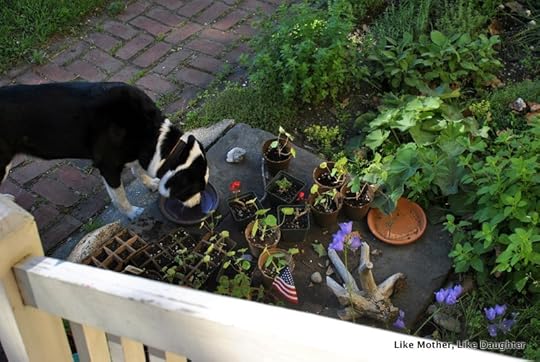

(You can consult the very first picture if you get lost on this tour.)
If I walk down, across the driveway, and turn with the house on my left and the clothesline right behind me, this is what I see:

If we number the beds 1-7 and go from left, below that green wagon, to right and top to bottom:
1. lettuce, peas, I dunno, maybe tomatoes? But if so, where are the eggplants I seeded? All the tags got mixed up.
2. cucumbers, peppers (I guess, or are those the eggplants? too small to tell right now), tomatoes
3. the bigger bushier tomato is from my Atrium kids, so of course it looks the best, a row of shallots, some Thai basil tucked in behind those, and then a row of tomatoes — the tomatoes I seeded are San Marzano, chocolate pear (little ones), and Brandywine, but no clue right now as to which are which
4. (we’re back and to the right of the compost — you can’t really see this bed in the photo) — garlic, zinnias, more tomatoes that didn’t fit anywhere else, rhubarb
5. green beans (and red and white)
6. tomatoes, basil, parsley which is so microscopic as to render any hope it will grow barely nil
7. tomatoes, bell peppers, a Hungarian pepper
A different view:

This picture is with the house on the right, now, and that compost set-up just to the right, out of the picture:



The Hungarian pepper plant, from a friend, “A little hot and sweet and delicious.” You know me, I’m a wimp about peppers, but I think the others will like it.
The shallots are growing well:

Our mulches are compost, horse manure from a nearby farm, and lawn and leaf clippings. The mulch for the paths is wood chips; I am sooooo lucky that my neighbor is a tree guy.

Now if I go beyond the clothesline, you see almost the whole garden. The house is on the left, the pictures that you saw above are at the top of the picture here, and then we have, moving down: clothesline, asparagus and strawberry beds (terrible this year, with the weird warm-then-freezing-then-raining-then-dry), raspberry bed (finally weed-controlled, we shall see), and then the last three beds that don’t actually get full sun, but in which I can grow some things, I hope.
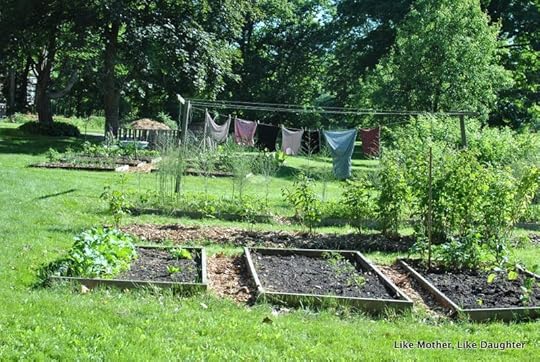
Already there: in the left bed, a healthy row of kale; in the middle bed, seeding some lettuce and beets, with yet another row of tomatoes; on the right, kale from last year, eggplants from the nursery, peppers, another tomato, and a ground cherry (also known as Cape gooseberry, also from the friend with the Hungarian pepper, whom I may or may not have given all my eggplant that I started from seed).
That last bed was me just not knowing what to do with all the plants.


In a fit of despair over the weedy asparagus bed and frustration over the strawberries growing where they ought not, I combined the two. The theory is that the asparagus has deep roots and the strawberries have shallow roots, so they should get on. So far I think that they need to be heavily mulched with manure in the fall, because this year is a bust. Also, re: strawberry excuses: birds, squirrels, even Roxie had her nose in there…
From the other side, now with the asparagus and clothesline and what I call “the upper garden” (closer to the house) behind me:

In the early spring, when I seeded that kale, I also sowed some lettuce. The lettuce in the upper garden did super well; this bed only gave me two, and that’s because it’s hard to get the hose down here/get to these beds when I’ve spent my time on the others, and the seeds dried out utterly:

But then I transplanted a bunch to this row. I hope that they won’t fry before they take. This bed — “the far garden” — gets shaded early from the trees that are beyond it and from the leach field (hill) which is above it (on the right of the picture, out of sight), so in theory, kale and lettuce should be good here.
Getting the raspberries under control was a huge boost. They need to fill in this bed on this side (one year a bunch died for some reason) so that the grasses don’t take over. Thanks to Bridget’s hard work, the wood chips give me the sense that things might prosper. Under the chips are all the grasses we cut, so hopefully the nitrogen from those will prevent the chips from pulling out nitrogen from the soil (and away from the raspberries) as they decompose.

I put the squashes in random places that were weedy and sunny. They aren’t proper beds, but last year when I did this I had huge success (with 24 butternut squashes from one plant!).

If any of this looks perfect to you (I only bring this up because somehow, people do seem to think it does), well, you are forgetting our country weeds and that any garden can look okay in June after many man-hours of work. We shall see in a month.
{funny and real}
Not garden related: I have two ovens in my range. I was making fixings for a fajita supper and was keeping things warm in the upper oven, including a glass pyrex with black beans. Of course, being me, I shoved stuff around in that hasty way of mine, and the pyrex fell over (but thankfully! didn’t break).
The beans spilled way in the back; and then we had to eat and then I had to garden and weed and paint stuff in the bathrooms and then I remembered.
So I put the oven on its clean cycle, which oddly did not rid me of my beans, although they were ashy and hard.
(There was a big pile, but I had already started sort of wiping them out with a paper towel when I remembered to take a picture for your amusement.)
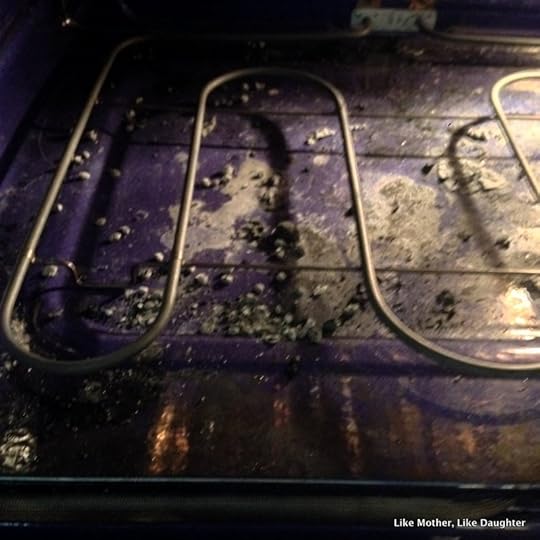
Paper-toweling wasn’t really working all that well.
So I vacuumed them out.

(Don’t worry, I emptied the vacuum and washed the filter!)
[image error] Loading InLinkz ...
The post {pretty, happy, funny, real} ~ garden progress and vacuuming old beans appeared first on Like Mother Like Daughter.
June 11, 2016
{bits & pieces}
The weekly “little of this, little of that” feature here at Like Mother, Like Daughter!
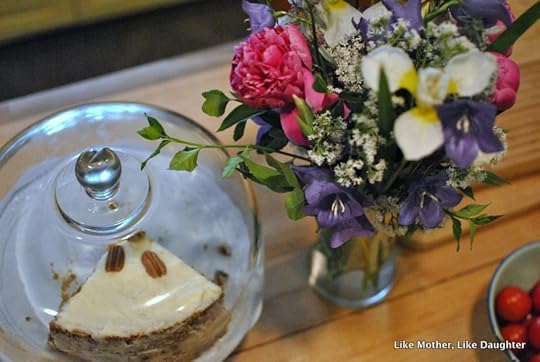

Good morning!
The peonies are blooming! They smell like heaven.
I’m itching to get out into the garden, aren’t you? Internet, garden. Internet, garden…
By the way, if you have garden-progress pictures, why not share them with us in the upcoming {pretty, happy, funny, real}, the link-up we do every Thursday? You can do a post on your blog or you can link an Instagram picture. I really have nothing interesting to show you other than my garden, so I’ll probably be posting about that too. We’d love to see your pictures!
We do have some good links for you!
I hope this article convinces you to stop with the educational time-wasters. Just have the courage to stop doing pointless or counterproductive things with your kids. The experts are not always right! And there is always an opportunity cost to any choice.
The Chief and I were just in Paris, and I’m bound to say that its beauty is something to contemplate. Would you and I make a virtue of wartime necessity as the Parisians did?
I thought you might like to hear a version of a piece we will sing at Mass tomorrow with our little volunteer choir (albeit in a slightly lower key). Many of our choir members are college- and high school- aged! Aim high, my friends! (We do have an amazing director and a wonderful legacy. Start getting yours! You can do it!)
People are confused, and I fear that even those who look on the Catholic Church from the outside, wondering where she leads if one follows her, find themselves confused. As a loyal Catholic who believes that the Pope represents St. Peter and continues his unbroken line of authority from the very dawn of the formation of the Body of Jesus Christ, I can’t pretend that I don’t find Pope Francis confusing and sometimes just wrong when his words are tested against the Gospel and the continuous teaching of the institution he ought to defend. There have been bad popes — history shows that clearly. This is not a bad thing — in fact, it demonstrates the indefectibility of her foundation: She will survive and has survived bad popes with her identity intact. Jeff Mirus has identified with admirable clarity and manly spirit just how this present pope has made standing for the truth difficult: On speaking the truth: Is confusion the chief “Francis effect”?
Speaking of speaking the truth, surrogacy is wrong. Always wrong, evil. It’s a kind of sex slavery and the very worst sort of prostitution. Especially if you live in Louisiana, you must read this article, but please read it wherever you are, and share it widely.
Jennifer Gregory Miller tells us all about the elevation of the celebration of St. Mary Magdalene to the status of feast. As she says, we have until July 22 to think of a nice way to honor her!
An interesting Facebook page about beauty (and ugliness) in architecture that you might want to follow. This post (without getting into the larger politics of this candidate) made me question why those running for office never pinpoint a specific policy they will change — they only ever say that they are for change itself! Odd. If someone came along and said, “I will change the zoning laws so that beautiful buildings can be built in our city again,” I would be very inclined to vote for him! In our visits to some European cities a few weeks ago, we couldn’t help noticing that we — and a bazillion other people — only wanted to see and to be in the old streets, delighting in the old buildings. Despite the huge amounts of money poured into the newer parts of those archetypal places — Rome, Florence, Paris, London — no one wants to go to those. Yet we are doomed to find the ancient charm unrepeatable. We doom ourselves! I thought that this post (on that same FB page) met — and challenged — that reality head on: The Beauty of Craft.
But — if you want a coherent explanation of why — of the objective reasons — one form of architecture delights the senses while another merely tweaks or offends them — you need this book: The Way of Beauty, by David Clayton. Bonus: It will help you figure out how to educate your older children in classical principles.
A funny send-up of music videos (although I admit that I find this form of music, even as parody, grating after about 3 seconds — if you ever want to know how to torture me, here you go):
From the archives:
The feast of the nativity of John the Baptist is coming up. I wrote about ways to celebrate it here (ignore the giveaway info, although of course the books are still relevant!).
And just before that, Father’s Day is coming! Don’t miss our truly epic gift-giving guide! Lots of great ideas there. By the way, you can use any Amazon link of ours to do any of your shopping on that site. When you do, we get a small portion. Thank you! This one works as well:
I did get my Spirit of the Liturgy post up yesterday. How is your reading going? Let us know in the comments to that post!
Happy feast of St. Barnabas! (Yes, we just use the word “feast” generically, even though it has a specific meaning — see, above, the link to the article about St. Mary Magdalene.)
~We’d like to be clear that, when we direct you to a site via one of our links, we’re not necessarily endorsing the whole site, but rather just referring you to the individual post in question (unless we state otherwise).~
Follow us on Twitter.
Like us on Facebook.
Auntie Leila’s Pinterest.
Rosie’s Pinterest.
Sukie’s Pinterest.
Deirdre’s Pinterest.
Habou’s Pinterest.
Bridget’s Pinterest.
Habou’s Blog: Corner Art Studio.
Auntie Leila’s Ravelry.
Auntie Leila’s Instagram.
Rosie’s Instagram.
Sukie’s Instagram.
Bridget’s Instagram.
The post {bits & pieces} appeared first on Like Mother Like Daughter.
June 10, 2016
The relationship of time and space in the liturgy ~ The Spirit of the Liturgy, a Book Club

{Book Club: The Spirit of the Liturgy}
I hope you will read along in this book club (or just read my posts, that’s okay): Joseph Ratzinger’s The Spirit of the Liturgy.
(When you buy something via our Amazon affiliate link, a little cash rolls our way… just a little. Thanks!)
I’ll post on Fridays, although for this longer book, perhaps not every Friday. I’ll give you your homework, I’ll talk about what we read, we’ll discuss in the comments. Even if you read later, the comments will still be open.
Previously:
Introduction to the reading: Joseph Ratzinger’s The Spirit of the Liturgy: A Book Club for Easter and Beyond
Nature or history in worship? Or both?
Homework: Read Chapter Two of Part II.
Chapter One, Part II: The Relationship of the Liturgy to Time and Space: Some Preliminary Questions
This chapter is not long and won’t take long to summarize.
I recently came across a dialogue on someone’s Facebook page that could serve as a jumping-off point for a discussion of this chapter — maybe it’s a question that you think about or that you’ve come across, namely, “Isn’t it enough that Jesus Christ died on the cross — as Scripture says, ‘Once and for all’?”
“It is accomplished,” he told us from the cross. The end. The rest of history is a working out of what that means for us, it seems.
Our task now, perhaps, is to remember and to imitate, and for this time and space exist.
Is that it? Ratzinger asks the same: On p. 53, “Is our divine worship not a matter of being loving people in our daily life?… Can there be any other holy time than the time for practicing love of neighbor, whenever and wherever the circumstances of our life demand it?”
There is truth in this way of looking at what it means to be a follower of Christ.
But… as I get older, I realize more and more that we can never be satisfied by that urge to summarize the meaning of life in “The One Thing You Need to Know” — There is no one thing! Our existence here on earth is precisely characterized by the tension of opposites (or seeming opposites) — the paradox of “opposing truth” that confronts us whenever we become comfortable with our formula, that “one thing” that will enable us to stop searching.
And indeed, if we pay attention to the Church’s Liturgical Year, the times she presents to us, time succeeding time, in which she takes the opportunity to spiral through all the “one things,” we undergo the challenge to our confidence that we have finally figured things out. The Year, containing all the commemorations and truths, presenting us to them all at once but also with different emphases, each enclosing at least the seeds of each, demonstrates that “And there are also many other things which Jesus did, the which, if they should be written every one, I suppose that even the world itself could not contain the books that should be written.” (John 21:25)
But I get ahead of myself.
Ratzinger here, in this chapter, wants us to know that the truth of this Event in the past shows us the “limits of human existence in this world” — the “not yet.”
Last week, as I was pondering this part of our book, we had the beautiful excerpt from St. Gregory the Great in the Office of Readings of the Liturgy of the Hours. Here is the complete reading for your consideration:
Since the dawn goes from darkness into light, it is right that the Church of the elect should be called “dawn” or “first light.” As it is led from the night of disbelief into the light of faith, it is opened up to the splendour of heavenly brightness just as the dawn bursts into day after darkness. How right are the words of the Song of Songs: Who is she who is coming up like the dawn? The holy Church seeks the rewards of heavenly life and is rightly called the dawn because it deserts the shadows of sin and sparkles in the light of righteousness.
There is something subtler to learn from this, on considering the nature of the dawn. Dawn, or first light, proclaims that the night is over but does not yet manifest the full brightness of the day. It dispels night, it gives a beginning to the day, but still it is a mixture of light and darkness. All of us who follow the truth in this life, are we not exactly like the dawn? Some of the things we do are truly works of the light, but others are not entirely free of the remnants of darkness. No man is virtuous before you, says the psalmist, and again Scripture says we have all done wrong in many ways.
This is why Paul does not say “the night has passed and day has come,” but night has passed and day is approaching, showing beyond doubt that he is still in the dawn, after the end of darkness but still before rising of the sun.
The Church of the elect will be fully day only when the darkness of sin is no longer mixed in with it. It will be fully day only when it shines with the perfect warmth of a light that comes from within. God shows that we are still going through this dawn when he says to Job, Have you ever sent the dawn to its post? Something that is being sent somewhere is being sent from one place or state to another. What is the destined place of the dawn if not the perfect brightness of the eternal vision? And when it has reached its place, will it still have any of the darkness of the night that has passed? The dawn was intent on reaching its destined place when the psalmist said My soul thirsts for the living God; when shall I appear before the face of God? The dawn was hurrying to the place it knew to be its destiny when Paul said that he wanted to die and to be with Christ, and when he said For me to live is Christ and to die is gain.
I had made a note of this reading at the end of the previous chapter, and then when I got to this one, here was the reference!
On p. 55, Ratzinger remarks on something I’m sure we’ve all experienced: how events of the past only have meaning when we look back on them in light of the experience when it is over. Memory is an essential, synthesizing component of understanding. So we have the events of the past, and then we have what he calls “the middle level,” which is the level of the liturgy — the “now.” But this “has meaning only in relation to something that really happens, to a reality that is substantially present.”
Far from being a fact of history that has disappeared into the past, that we can remember only with difficulty, Jesus’ sacrifice — his giving “inserted into the everlasting Yes of the Son to the Father” — the human will of Jesus united with his divine will — “draws the passion of human existence into the action of love… time is drawn into what reaches beyond time… time can again and again be brought into it. That is how we can become contemporary with the past events of salvation.” (P. 56)
Understanding this requires keeping in mind the perfect union of Jesus’ divine and human natures. This union is the hinge on which swings all of time and space — and eternity, from our point of view.
Not only is this union (the “hypostatic union,” you will remember) what makes us capable of being present for an event that seems past, it is what also brings the future into the now.
If past and present penetrate one another in this way, if the essence of the past is not simply a thing of the past but the far-reaching power of what follows in the present, then the future, too, is present in what happens in the liturgy: it ought to be called, in its essence, an anticipation of what is to come.
Not only the eschaton, the Second Coming; also the taking up of ourselves, whom the sacrifice represents — that in fact we may become a living sacrifice, that “his self-giving is meant to become mine.” Later on p. 58, Ratzinger says, “That is why, in the petitions for acceptance, we pray that representation become a reality and take hold of us.”
The once-for-all wants to attain its always.
I think you can see that this is a substantially different view of what goes on in church than the idea that we are hearing some motivating words about a holy man and spending some time thinking — or even praying — about them.
As he often does, thankfully, Ratzinger gives us a little summary of his points in this chapter, starting at the bottom of p. 59:
Firstly: The liturgy, as we saw, is characterized by the once-for-all, historical Pasch of Jesus — his Cross and Resurrection.
Secondly: The eternal enters into our present moment in the liturgical action (the Mass — the only way this is accomplished; there is no other claim to doing just this).
Thirdly: We grasp “the desire of the eternal to take hold of the worshipper’s life and ultimately of all historical reality. The immediate event — the liturgy — makes sense and has a meaning for our lives only because it contains the other two dimensions. Past, present, and future interpenetrate and touch upon eternity.” (P. 60)
And all of this is to say that we inhabit this “in-between” place, and it is “only mediated by the signs of salvation. We need mediation.” Why? because we are not in the dawn, in the light — not yet! We are in the dimness of the space between night (not seeing) and day (seeing face to face), as St. Gregory so beautifully puts it.
That means, then, that here and now is a place and time of images and symbols. We need the material, without being bound by it. Just as Jesus is true man and true God, and thus forms the bridge between heaven and earth, so we need the material world to be able to find and attain the eternal world.
We have to have a way to express the historical, the moment we inhabit, and the future: “a theology of symbols, which connects us to what is present but hidden.”
Ratzinger ends the chapter by giving us the answer to the question, “Do we still need sacred space, sacred time, mediating symbols?”
Yes!
“We do indeed participate in the heavenly liturgy, but this participation is mediate to us through earthly signs, which the Redeemer has shown to us in the place where his reality is to be found.”
I love how his last sentence is so earthy, so sign-wedded, so grounded not in a philosophical formulation but in a parable: “The Shepherd takes the lost sheep onto his shoulders and carries it home.”
Let us know in the comments what you made of this chapter. We love hearing from you!
(Emphases added in quotes are mine.)
Click here to see our previous discussion of Romano Guardini’s The Spirit of the Liturgy, which you can read free, online. You can also purchase it here, although be warned, this edition does not have the footnotes, which stinks .
.
The post The relationship of time and space in the liturgy ~ The Spirit of the Liturgy, a Book Club appeared first on Like Mother Like Daughter.








